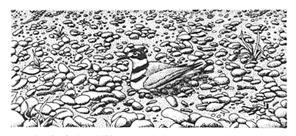|
Birds are, hands down, the most colorful terrestrial vertebrates -- only insects and coral reef fishes rival them among animals. Birds, like butterflies and moths, have two basic sources of color. The more common is pigments, which are chemical compounds located in the feathers or skin. Pigments absorb some wavelengths of light and reflect others; it is the reflected light that reaches our eyes. The color we perceive is a function of the wavelength of the light stimulating the receptors of our retinas. In the visual part of the electromagnetic spectrum, we see the shortest wavelengths as "violet" and the longest as "red." Thus a cardinal has pigment in its feathers that absorbs all the wavelengths except the ones that, when they enter our visual system, register as red. When no light is reflected we see black; when all wavelengths are reflected we see white. Blue and iridescent colors in birds are never produced by pigments, however. They are "structural colors." The blues are produced by minute particles in the feather that are smaller in diameter than the wavelength of red light. These particles are able to influence only shorter wavelengths, which appear blue, and are "scattered" -- reflected in all directions. Thus structural blue colors remain the same when they are viewed at different angles in reflected light. If, however, they are viewed by transmitted light (that is, with the feather between the light source and the observer), the blue disappears. Iridescent colors are produced by differential reflection of wavelengths from highly modified barbules of the feathers that are rotated so that a flat surface faces the incoming light. The detailed structure of the barbule reflects some wavelengths and absorbs others, and the reflected wavelength changes with the angle of reflection. The structural color is registered by the eye in response to the reflected wavelengths and changes with the angle formed by the light, the reflecting surface, and the eye. Just as bird songs did not evolve to please the human ear, bird colors did not evolve to delight our eyes. The most spectacular colors typically function to impress members of the same species. The classic example is the tail of the peacock, but the brilliant colors of the breeding male Scarlet Tanager or male King Eider illustrate the same phenomenon. Nondemonstrative colors frequently help a bird avoid predation. The camouflage of a King Eider female on its nest is an example of such cryptic coloration. Many inconspicuous birds exhibit what is known as "countershading"; they are darkest along the back, and gradually become lighter until the belly is pure white. Countershading tends to eliminate a sharply defined shadow, since the bird absorbs the most light above, where the light is brightest, and reflects the most light below, where the light is dimmest. The vast majority of shorebirds are countershaded, although as in the Snowy Plover the division between darker back and lighter belly may be rather sharp. "Disruptive" coloration -- the use of striking patterns to break up the outline of the bird -- is another technique for avoiding detection. Killdeer and Semipalmated Plovers, for example, are very difficult to see in some circumstances. The extreme in cryptic coloration, of course, is found among those birds that simply take on the color of the background against which they live. Ptarmigans in their pure white winter plumage are the classic example. Birds often use colors to identify themselves to other members of their flock and thus to hold it together. Examples are the color patterns revealed in flight by shorebirds such as Ruddy Turnstones and Willets. Colors, such as those inside the mouths of gaping chicks, may also function to stimulate parental feeding. Other colors may direct the feeding movements of the young, as does the red spot on the bill of the Herring Gull, which encourages the young to solicit food and to stick its head into the adult's mouth.
Some colors are apparently produced incidentally by pigments deposited for other reasons. For instance, feathers of the wingtips are subjected to more wear than those nearer the base of the wing. And feathers containing pigments are more resistant to wear than those without. That is thought to be the reason that the wingtips of many mostly white birds, such as many gulls, terns, pelicans, and gannets, are dark. Disruptive coloration in the Killdeer. The alternating bands of white and black on the head and neck break up the outline of the bird and make it more difficult to see against a variegated background than a bird that is uniformly light or dark. SEE: Molting; Bird Badges; Visual Displays. Copyright ® 1988 by Paul R. Ehrlich, David S. Dobkin, and Darryl Wheye. |
